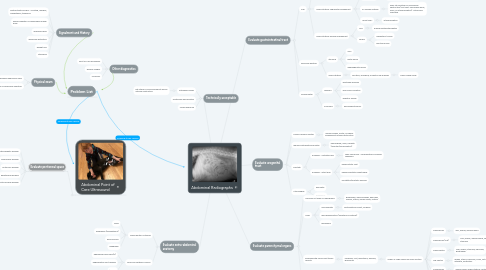
1. Signalment and History
1.1. gastrointestinal signs - vomiting, diarrhea, inappetence, tenesmus
1.2. known ingestion of radiopaque foreign body
1.3. abdominal pain
1.4. abdominal distention
1.5. weight loss
1.6. stranguria
2. Other diagnostics
2.1. Point of Care bloodwork
2.2. Referral images
2.3. Urinalysis
3. Physical exam
3.1. palpable abdominal mass
3.2. pain on abdominal palpation
4. Problem List
5. Technically acceptable
5.1. orthogonal views
5.1.1. left lateral if concerned about pyloric outflow obstruction
5.2. Positioned appropriately
5.3. Proper exposure
6. Abdominal Point of Care Ultrasound
6.1. Evaluate peritoneal space
6.1.1. diaphragmaticohepatic window
6.1.2. splenorenal window
6.1.3. cystocolic window
6.1.4. hepatorenal window
6.1.5. ventral midline window
7. Evaluate extra-abdominal anatomy
7.1. visible portion of thorax
7.1.1. lungs
7.1.2. esophagus (mediastinum)
7.1.3. pleural space
7.1.4. diaphragm
7.2. limbs and vertebral column
7.2.1. aggressive bone lesion(s)
7.2.2. degenerative joint disease
7.2.3. trauma
8. Evaluate gastrointestinal tract
8.1. Size
8.1.1. Stomach enlarged (normal position)
8.1.1.1. Contains feed (granular material)
8.1.1.1.1. food bloat or normal post-prandial
8.1.1.2. Contains foreign material
8.1.1.2.1. Does the material remain within the pylorus on both laterals? pyloric outflow obstruction or anchored linear foreign body
8.1.2. Small intestinal Segmental enlargement
8.1.2.1. foreign material
8.1.2.1.1. positive for mechanical obstruction
8.1.2.2. no foreign material
8.1.2.2.1. likely still positive for mechanical obstruction (just can't see foreign body, mass, or intussusception). Ultrasound indicated
8.1.2.3. "bullet sign"
8.1.2.3.1. intussusception
8.1.3. Small intestinal Diffuse enlargement
8.1.3.1. Mild
8.1.3.1.1. diffuse gastroenteropathy
8.1.3.2. Severe
8.1.3.2.1. mesenteric torsion
8.1.3.2.2. functional ileus
8.2. Abnormal position
8.2.1. stomach
8.2.1.1. GDV
8.2.1.2. hiatal hernia
8.2.1.3. diaphragmatic hernia
8.2.2. small intestine
8.2.2.1. plication, bunching, eccentric gas bubbles
8.2.2.1.1. linear foreign body
8.3. Serosal detail
8.3.1. reduced
8.3.1.1. peritoneal effusion
8.3.1.2. poor body condition
8.3.1.3. pediatric animal
8.3.2. increased
8.3.2.1. pneumoperitoneum
9. Evaluate urogenital tract
9.1. Mineral opaque uroliths
9.1.1. urinary bladder, ureter, or kidney enlargement implies obstruction
9.2. reduced retroperitoneal detail
9.2.1. hemorrhage, urine, exudate (infection/inflammation)
9.3. Prostate
9.3.1. enlarged - castrated dog
9.3.1.1. likely carcinoma - mineralization increases likelihood
9.3.2. enlarged - intact dog
9.3.2.1. paraprostatic cyst
9.3.2.2. benign prostatic hypertrophy
9.3.2.3. prostatitis/prostatic abscess
9.4. Uteromegaly
9.4.1. pyometra
9.4.2. pregnancy
10. Evaluate parenchymal organs
10.1. Normally not seen on radiographs
10.1.1. gallbladder, adrenal glands, pancreas, ovaries, uterus, lymph nodes, ureters
10.2. Small
10.2.1. microhepatia
10.2.1.1. portosystemic shunt, cirrhosis
10.2.2. renal degeneration (unilateral or bilateral)
10.2.3. hypoplasia
10.3. Enlarged with normal soft tissue opacity
10.3.1. neoplasia, cyst, hematoma, abscess, granuloma
10.3.1.1. Organ of origin based on mass location
10.3.1.1.1. Craniodorsal
10.3.1.1.2. Craniodorsal (left)
10.3.1.1.3. Cranioventral
10.3.1.1.4. Mid-ventral
10.3.1.1.5. Caudodorsal
10.3.1.1.6. Caudoventral
10.3.1.1.7. Retroperitoneal
10.4. Enlarged with gas opacity
10.4.1. abscess
